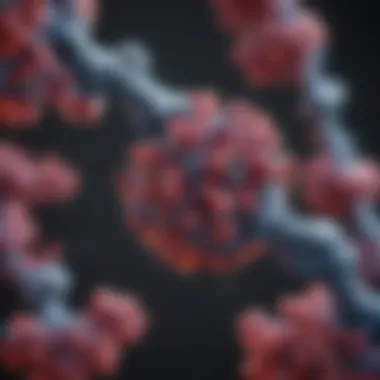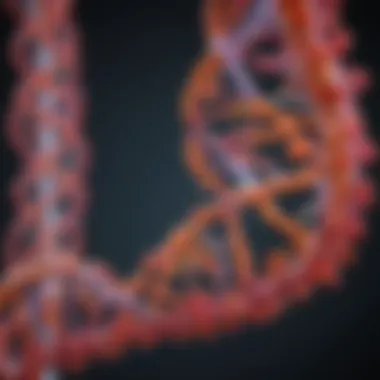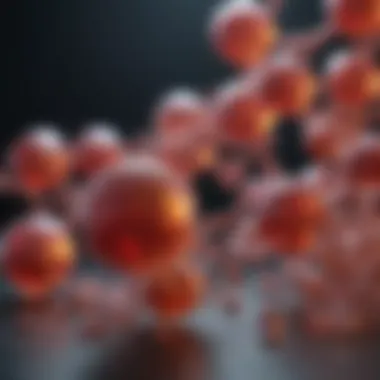Exploring the Impact of PARP Inhibitors on Cancer Therapy


Intro
Poly ADP-ribose polymerase (PARP) inhibitors have emerged as a significant advancement in cancer treatment. Their unique mechanisms of action target the DNA repair pathways that cancer cells exploit. As scientists continue to delve into the complexities of cellular repair mechanisms, understanding PARP inhibitors becomes imperative. This is not only relevant for oncology but also for advancing pharmacotherapy as a whole.
In this article, we explore PARP inhibitors' features comprehensively. From their modes of action to clinical applications, the aim is to provide insights that are both detailed and accessible. As we navigate this intricate landscape, we will also discuss the challenges posed by resistance mechanisms and the future trajectory of research in this field.
Understanding PARP inhibitors is essential for professionals and students alike who are focused on cancer research and treatment. These inhibitors are reshaping how we approach not just cancer but also the underlying biological principles that govern cellular life and repair.
Preamble to Poly ADP-Ribose Polymerase
The study of Poly ADP-Ribose Polymerase (PARP) highlights a vital area in biomedical science. The significance of PARP inhibitors is increasingly noted in modern cancer pharmacotherapy, mainly due to their role in DNA repair mechanisms. This section introduces the definition, historical context, and importance of PARP in cellular biology, setting the foundation for a deeper understanding of their applications and mechanisms.
Definition and Function
Poly ADP-Ribose Polymerase refers to a family of enzymes playing a key role in cellular processes, particularly in response to DNA damage. These enzymes function by adding ADP-ribose units to various target proteins. This action triggers the repair of damaged DNA through a process known as post-translational modification. In essence, PARP aids in detecting and initiating the repair of single-strand breaks in DNA. The inhibition of PARP can have profound effects on cancer cells, especially those with pre-existing DNA repair deficiencies. This makes the understanding of PARP's function essential when discussing potential therapeutic interventions.
Historical Context
The discovery of PARP dates back to the late 1960s when researchers first identified its role in cellular processes. Over the years, its function in DNA repair became clearer, prompting further investigations. The idea of using PARP inhibitors as a therapeutic strategy gained traction in the early 2000s, particularly after studies demonstrated that certain cancers exhibit vulnerabilities due to their reliance on PARP for repair mechanisms. The successful application of PARP inhibitors in models of breast and ovarian cancers sparked significant interest, leading to clinical trials and eventual FDA approvals.
Importance in Cell Biology
PARP enzymes are crucial in maintaining genomic stability. This stability is vital for normal cell functions. Furthermore, dysfunction in the PARP pathway has been linked to various diseases, including cancer. By understanding the role of PARP within cell biology, researchers can explore novel approaches to target cancer cells more effectively. The inhibition of PARP poses a unique challenge yet presents an opportunity for developing precision therapies tailored to individual genetic profiles.
"The inhibition of PARP offers a pathway to exploit the unique DNA repair vulnerabilities of cancerous cells, making it an area of profound interest for research and treatment."
Through these insights, the importance of PARP in both cellular processes and cancer therapy becomes evident. This foundational knowledge supports the subsequent exploration of PARP inhibitors, their mechanisms of action, and their clinical relevance.
Mechanism of Action of PARP Inhibitors
Understanding the mechanism of action of PARP inhibitors is crucial to appreciate their role in cancer therapy. These compounds specifically target the poly ADP-ribose polymerase enzymes, leading to targeted DNA damage in cancer cells. Their unique mechanism makes them an essential part of current oncological strategies, especially in cancers linked to deficiencies in homologous recombination repair, such as those associated with BRCA mutations.
Inhibition of PARP Enzymes
PARP enzymes play a vital role in the cellular repair processes. They are primarily involved in detecting and repairing single-strand breaks in DNA. By inhibiting these enzymes, PARP inhibitors disrupt the repair mechanism. This action is particularly significant in cancer cells, where the reliance on PARP for DNA repair is often heightened due to existing defects in other pathways, such as homologous recombination. The inhibition effectively creates an accumulation of DNA breaks, ultimately leading the cancer cell to apoptosis.
Impact on DNA Repair Pathways
The impact of PARP inhibition on DNA repair pathways is profound. When PARP is inhibited, the cell cannot effectively repair single-strand breaks, which can lead to double-strand breaks during replication. In normal cells, homologous recombination can repair these breaks. However, in BRCA-deficient tumors, this path is already compromised. Thus, the employment of PARP inhibitors results in synthetic lethality. This term refers to the scenario where the combined deficiencies of two pathways lead to cell death, while either pathway alone would not.
- Key Points on DNA Repair:
- Accumulation of DNA single-strand breaks.
- Formation of double-strand breaks that cannot be repaired in BRCA-deficient tumors.
- Induction of cell death through synthetic lethality.
Cellular Consequences of PARP Inhibition


The cellular consequences of PARP inhibition are multifaceted. As the accumulation of DNA damage increases, cells experience significant stress, which affects their stability and proliferation. In a healthy environment, cells repair damage efficiently, but cancer cells, especially those reliant on PARP, exhibit vulnerabilities when this repair machinery is hindered. The inability to repair damaged DNA leads to cellular dysfunction and, ultimately, apoptosis. Additionally, the immune system may recognize and attack these compromised cells more effectively, potentially improving therapeutic outcomes.
"The targeted mechanism of PARP inhibitors showcases the delicate balance between cancer cell viability and DNA repair efficiency. Understanding this relationship is pivotal in maximizing clinical benefits."
The exploration of the mechanism of action of PARP inhibitors reveals their potential to change treatment landscapes, particularly for specific cancer treatments. This insight forms the foundation for understanding their clinical applications, necessitating further investigation into their efficacy and safety profiles.
Clinical Applications of PARP Inhibitors
The clinical applications of poly ADP-ribose polymerase (PARP) inhibitors are a significant focus of current cancer research and treatment paradigms. These agents have influenced therapeutic strategies, especially in oncology. They offer new avenues for treatment, particularly in cancers with underlying genetic mutations.
PARP Inhibitors in Oncology
PARP inhibitors are primarily used in oncology, targeting tumors with deficiencies in DNA repair mechanisms. This is especially relevant for cancers associated with BRCA1 and BRCA2 mutations. By inhibiting PARP, these agents prevent cancer cells from repairing their DNA, leading to increased apoptosis or programmed cell death. For instance, Olaparib and Niraparib have shown effectiveness against ovarian and breast cancers with specific genetic markers. Their use has brought forward a paradigm shift in how certain cancers are treated, making them more manageable and potentially enhancing patient survival rates.
Current Treatments and Efficacy
Current treatments utilizing PARP inhibitors have demonstrated notable efficacy. Clinical trials show that patients who receive PARP inhibitors, particularly those in advanced stages of cancer, can experience longer progression-free survival. For example, studies discussing Olaparib have reported an improvement in response rates compared to traditional therapies in BRCA-mutated tumors.
The effectiveness, however, can vary based on individual patient factors, including genetic background and previous treatments. The incorporation of PARP inhibitors often leads to a more detailed patient assessment, aiming to tailor therapies for maximal effectiveness. Achieving a comprehensive understanding of these factors is essential in advancing therapy and ensuring better patient outcomes.
Combination Therapies
Combination therapies integrate PARP inhibitors with other treatment modalities, enhancing their potential efficacy. Current strategies often couple these inhibitors with chemotherapeutic agents or immunotherapy. For instance, combining Olaparib with cisplatin has shown synergistic effects in preclinical models.
Moreover, the quest for optimizing treatment regimens involves a clear understanding of how these combinations can address tumor heterogeneity and resistance mechanisms.
"Combining PARP inhibitors with other therapies may provide a more robust strategy to combat tumor resistance and recurrence, although this requires careful consideration of the safety profiles of each agent."
Such combinations are subject to ongoing clinical trials, aiming to unveil the optimal strategies for enhancing therapeutic outcomes without significant toxicity risks. The goal remains to achieve effective treatments that not only prolong life but also maintain quality of life for patients in clinical settings.
Understanding Resistance Mechanisms
Resistance to PARP inhibitors represents a critical area of investigation in cancer therapy. Understanding these mechanisms is essential for improving treatment outcomes and enhancing the effectiveness of pharmacological strategies. Resistance can hinder the effectiveness of PARP inhibitors, resulting in treatment failure and poorer patient prognosis. Thus, analysis of resistance mechanisms is paramount in designing new therapeutic approaches and tailoring treatments to individuals.
Intrinsic Resistance Factors
Intrinsic resistance refers to the natural ability of certain tumor cells to resist the effects of PARP inhibitors despite prior exposure. This characterization includes several underlying biological factors:
- Genetic variations: Specific mutations in genes involved with DNA repair can lead to an inherent resistance to PARP inhibition. For example, mutations in the BRCA1 or BRCA2 genes can alter the efficacy of PARP inhibitors.
- Enhanced DNA repair capacity: Some tumors may have an upregulated expression of alternative DNA repair pathways. This increase allows them to effectively bypass the inhibition caused by PARP inhibitors.
- Tumor microenvironment: Variations in the tumor microenvironment, including hypoxia and fluctuating pH levels, can also contribute to baseline resistance.
These factors can significantly influence how patients respond to PARP inhibitors, complicating treatment landscapes.
Acquired Resistance in Tumors
Acquired resistance develops when tumors evolve in response to PARP inhibitor treatment. This form of resistance emerges after an initial period of sensitivity and includes several mechanisms:
- Secondary mutations: Tumors may acquire secondary mutations in the BRCA1 or BRCA2 genes, causing loss of functionality of these genes, which diminishes the effectiveness of PARP inhibitors.
- Drug efflux pumps: Overexpression of drug efflux transporters can lead to decreased intracellular concentrations of PARP inhibitors, weakening their therapeutic effect.
- Altered signaling pathways: Cancer cells may adjust their biochemical pathways to become less reliant on the mechanisms targeted by PARP inhibitors, facilitating continued survival despite treatment.


Recognizing and addressing acquired resistance is crucial to enhancing the longevity of PARP inhibitor efficacy in clinical settings.
Strategies to Overcome Resistance
To improve the effectiveness of PARP inhibitors in the face of resistance, several strategies are being explored:
- Combination therapies: Combining PARP inhibitors with other agents can provide a synergistic effect, potentially overcoming resistance. For instance, combining these inhibitors with platinum-based chemotherapy, such as cisplatin, can enhance anti-tumor efficacy.
- Targeting alternative pathways: Identifying and targeting alternative DNA repair mechanisms may help overcome resistance. For example, employing inhibitors that affect other components of the DNA repair system can make cancer cells more vulnerable.
- Personalized treatment approaches: Tailoring therapies to specific genetic profiles of tumors can enhance effectiveness. Genomic profiling can guide treatment decisions and improve the overall success rates of using PARP inhibitors.
"Understanding and addressing resistance mechanisms is vital for the successful application of PARP inhibitors in cancer therapy."
Through a comprehensive understanding of resistance mechanisms, the field of cancer therapy can move towards more effective and individualized approaches.
Recent Advances in PARP Inhibitor Research
The exploration of poly ADP-ribose polymerase (PARP) inhibitors has reached new heights in recent years. This section delves into the recent advances in PARP inhibitor research. Understanding these developments is essential for anyone interested in the progress of cancer therapies and the ongoing evolution of precision medicine. New knowledge and innovations are reshaping how PARP inhibitors are perceived and utilized in clinical settings.
Novel PARP Inhibitors in Development
Research into novel PARP inhibitors has produced promising results. Some compounds are showing enhanced potency against cancer cells with specific defects in DNA repair mechanisms. One such example is the emerging drug called talazoparib. Talazoparib is noted for its high trapping ability compared to older PARP inhibitors. This means it can accumulate on PARP-DNA complexes more effectively, potentially leading to greater antitumor effects.
Additionally, new studies are evaluating the use of dual inhibitors that target both PARP and other pathways that cancer cells may exploit. For instance, compounds that inhibit a second enzyme while affecting PARP could lead to more robust treatment regimens, particularly for tumors resistant to traditional therapy.
Clinical Trials and Outcomes
Clinical trials remain a cornerstone in the evolution of PARP inhibitors. Several recent trials have highlighted the efficacy of these drugs in various cancer types, including ovarian and breast cancer. For example, the OlympiAD trial investigated the effects of olaparib on patients with BRCA1 or BRCA2 mutations. The results indicated a significant improvement in progression-free survival compared to standard chemotherapy.
Furthermore, ongoing phase III trials are examining combination therapies that include PARP inhibitors alongside immunotherapies or traditional chemotherapies. Preliminary results are encouraging, suggesting that such combinations may potentiate the anticancer effects of PARP inhibition while helping to overcome resistance mechanisms that tumors develop.
"The integration of PARP inhibitors into clinical practice is evolving rapidly, with ongoing trials continuously reshaping our understanding of their therapeutic potential."
Emerging Therapeutic Areas
Researchers are now exploring multiple emerging therapeutic areas for PARP inhibitors. Beyond their traditional use in breast and ovarian cancers, there is growing interest in applying them to prostate cancer and pancreatic cancer. Some studies show that tumors with defective homologous recombination repair may also respond to PARP inhibition, suggesting a wider application of these therapies.
Another area of exploration includes the role of PARP inhibitors in combination with radiotherapy. Given that DNA damage is a key action of radiation therapies, researchers hypothesize that PARP inhibitors could enhance the therapeutic effects of radiation.
Safety and Toxicity Profiles
The evaluation of safety and toxicity in the use of PARP inhibitors is paramount in clinical settings. As these drugs gain prominence in cancer treatment, understanding their side effects and long-term implications becomes essential. Safety profiles inform clinicians of the risks involved, providing guidance on patient management and therapeutic approaches. Successful integration of PARP inhibitors into treatment regimens hinges on balancing their efficacy with potential adverse effects.
Common Side Effects
PARP inhibitors can trigger a range of side effects. Patients often experience:
- Nausea and Vomiting: These are among the most reported side effects, affecting the patient's quality of life.
- Fatigue: This can be debilitating and may impact daily activities.
- Anemia: Reduced red blood cell count can lead to weakness and shortness of breath.
- Diarrhea: This issue can become troublesome and may lead to dehydration.


Severity and frequency of these side effects vary by individual and specific PARP inhibitor used, such as Olaparib or Niraparib. Healthcare providers must educate patients about these risks before starting treatment. Monitoring and supportive care can help manage these issues, ensuring patients remain compliant with their regimen.
Long-Term Toxicity Considerations
The long-term safety of PARP inhibitors is still under investigation. There are concerns related to chronic exposure. For example:
- Risk of Secondary Cancers: Emerging evidence suggests that prolonged use of these inhibitors could be linked to an increased risk of developing secondary malignancies. The exact mechanisms behind this potential risk remain unclear, necessitating further studies.
- Impact on Healthy Tissue: While designed to target cancer cells, PARP inhibitors might also affect normal cells involving DNA repair mechanisms, leading to unintended consequences.
Regular follow-up with patients receiving PARP therapy is critical to monitor for late-onset side effects. Understanding these long-term implications facilitates informed decision-making in treatment strategies, paving the way for enhanced personalized medicine approaches.
"A clear comprehension of safety and toxicity profiles is as important as understanding the therapeutic benefits of PARP inhibitors. The balance between efficacy and safety can significantly influence treatment outcomes."
In summary, the safety profiles of PARP inhibitors encompass a broad spectrum of immediate and long-term concerns. Ongoing research aims to refine these understanding and develop strategies to mitigate risks, thus ensuring that the promise of PARP inhibitors translates into effective and safe patient care.
Future Directions and Perspectives
The realm of poly ADP-ribose polymerase (PARP) inhibitors is evolving. Comprehensive understanding of their future applications is essential. Different strategies can enhance their effectiveness in cancer treatment and other medical fields. Emphasizing novel approaches and personalized medicine can redefine therapeutic strategies.
Innovative Approaches to PARP Inhibition
Recent studies have indicated several innovative methodologies regarding PARP inhibition. One notable direction is the development of next-generation PARP inhibitors that demonstrate improved potency and selectivity. These novel compounds aim to minimize resistance observed with current therapies. Enhanced delivery systems, like nanoparticles, also show promise. They can increase drug concentration at tumor sites while reducing systemic exposure. This can limit side effects significantly.
Additionally, combination therapies that integrate PARP inhibitors with other treatments are gaining attention. Studies have highlighted the potential benefits of combining PARP inhibitors with immunotherapy agents. This could leverage the immune system alongside targeted therapy, providing a multifaceted approach against tumors.
Moreover, biomarkers are a focal point in the advancement of PARP inhibition strategies. Identifying specific genetic profiles in tumors can aid clinicians in determining which patients would benefit most from PARP inhibitors. For instance, tumors with BRCA1 or BRCA2 mutations often exhibit sensitivity to these agents. Tailoring treatments based on genetic insights can optimize outcomes for patients.
Integrating PARP Inhibitors into Personalized Medicine
Personalized medicine continues to transform how therapies are approached in oncology. PARP inhibitors, in particular, fit well within this model. The integration begins with understanding the individual patient’s tumor characteristics. Genetic testing is vital in this process, enabling healthcare providers to identify patients who will likely respond to PARP inhibition.
Incorporating data from clinical trials can help refine and tailor these treatments further. It allows the development of treatment plans that align closely with the patient's specific genetic makeup and tumor biology. For example, assessing the presence of homologous recombination deficiency can guide the use of PARP inhibitors in appropriate settings.
Beyond genetic factors, the consideration of overall health status and other comorbidities is also critical. By assessing how other medications or conditions might interact, healthcare providers can create a comprehensive treatment strategy. This approach not only improves efficacy but minimizes potential adverse effects as well.
"Integrating PARP inhibitors into personalized medicine necessitates an understanding of both genetic factors and patient-specific considerations to achieve optimal outcomes."
In summary, the future of PARP inhibitors lies in innovative therapeutic strategies and personalized treatment plans. As research progresses, the balance of efficacy, safety, and individual variation will be increasingly paramount. Addressing these factors through tailored approaches holds significant potential for transforming patient experiences in oncology.
Ending
The realm of poly ADP-ribose polymerase (PARP) inhibitors marks a significant advance in cancer therapeutics. Understanding the functionality and clinical application of these inhibitors is crucial for their effective use in treating malignancies. This article encapsulates essential findings regarding the role of PARP inhibitors and their interactions within cellular mechanisms.
Summary of Findings
Over the course of this discussion, several key points have emerged. Firstly, PARP inhibitors have a well-established role in targeting tumor cells with defective DNA repair mechanisms, particularly those associated with BRCA1 and BRCA2 mutations. The inhibition of PARP enzymes leads to the accumulation of DNA damage, ultimately resulting in cell death. Secondly, clinical applications show promise, especially in the treatment of breast and ovarian cancers. Studies demonstrate that patients receiving these treatments experienced improved outcomes compared to traditional therapies.
Moreover, the development of resistance to PARP inhibitors presents a formidable challenge. Identifying the intrinsic and acquired resistance mechanisms is vital for enhancing treatment efficacy. There is a need for ongoing research into these areas to devise effective strategies that could mitigate resistance and improve patient outcomes.
Implications for Future Research
Looking ahead, the prospects for PARP inhibitor research are substantial. Future studies might focus on innovative ways to enhance the effectiveness of PARP inhibition, perhaps through combination therapies with other agents. Research into integrating these inhibitors within personalized medicine is essential, as genetic profiling can guide tailored treatments that maximize therapeutic benefit.
Furthermore, assessing long-term safety and toxicity profiles will be vital, considering the extended duration of treatment that may be necessary for some patients. There is also a growing need to explore and validate novel PARP inhibitors currently in development and clarify their positions in the therapeutic landscape.



